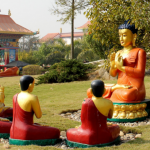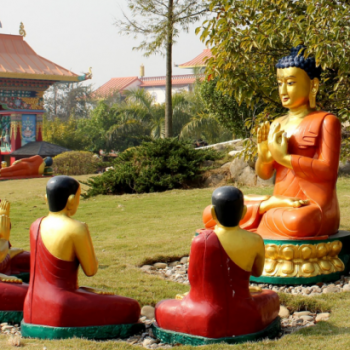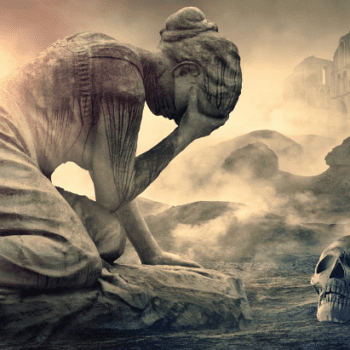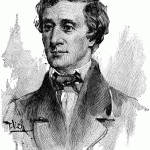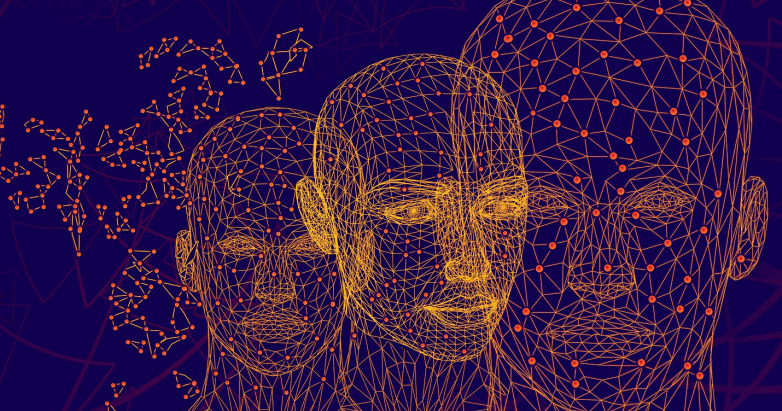
The Buddha said:
Moral character is preceded by intention, ruled by intention, produced by intention. If with a corrupt intention one speaks or acts, then unhappiness will follow them like the (Wagon) Wheel follows the foot of the (animal) that pulls it (Dhp 1-2 Forrest).
In Buddhism, the three trainings are morality, meditation, and wisdom. The training begins with morality. It is the foundation for meditation and wisdom. But in order to understand Buddhist morality correctly, one must understand karma and the motive base of action. I am not sure this is widely known.
The Background
The is a Dhammapada Commentary that goes with the Dhammapada. In it, are stories that illuminate and illustrate the verses in the Dhammapada. These are said to be quite old, but many of the stories seem more like folklore than historical fact. This is not as important if we take them as illustrations rather than historical reports. The important point is that they help us interpret the verse according to the traditional understanding. Not that the traditional understanding is infallible, but it is more probably correct.
So this verse of the Dhammapada has a story that comes with it. The Pali commentary explains that a fully awakened monk, who was blind, was doing walking meditation one morning. While he was walking back and forth, he stepped on some bugs in the path. Some monks, horrified at what they saw, went to the Buddha to report what they saw. The Buddha explained that he has killed them unintentionally, having “no thought of killing,” and therefore was not guilty (Burlingame 157).
The Buddha then tells the story of how the monk ended up blind before he could be fully awakened. The short version is that in a previous life he used to be a physician. A woman came to him with her eyesight failing. She didn’t have any money and promised to become his slave if he cured her. He did cure her, but she hid the fact that she could see again, trying to deceive him. The physician realized her deception and thought, “This woman is deceiving me because she is unwilling to give me anything. I don’t want her fee; now I will make her blind” (Burlingame 158). And so he gave her some medicine that blinded her permanently. The Buddha explained that this “evil deed” had “followed him ever after.” The Buddha then utters this verse.
Intention is Karma
The Buddha said:
“It is volition, bhikkhus, that I call kamma” (AN 6.63 Bodhi).
“Intention, I tell you, is kamma” (AN 6.63 Thanissaro).
“Monks, I say that determinate thought is action” (AN 6.63 Hare).
The Pali word kamma is the equivalent of the Sanskrit word karma. I use the better known word when talking about karma. The Buddha is clear, “It is intention that I call karma” (AN 6.63 Forrest). The Pali word translated as intention is cetanā. New Concise Pali English Dictionary defines it as “intention; volition” (SuttaCentral). The Concise Pali English Dictionary defines it as “intention” (SuttaCentral). PTS Pali English Dictionary defines is as, “state of ceto in action, thinking as active thought, intention, purpose, will defined as action” (SuttaCentral).
Karma, which is in Pali kamma, is defined by the New Concise Pali English Dictionary as, an “act, deed, action or actions of moral import (producing for the agent an inevitable result or consequence in the same or another life; the action appears to exist in some sense until the effect is completed)” (SuttaCentral). It is intention that imparts “moral import” into an action. This is so important to understand.
It might be good to explain the meaning of intention as used by the Buddha. Have you ever heard the saying, “The road to hell is paved with good intentions”? Here the meaning of intention is, according to Webster’s New World College Dictionary (5th ed.), “having something in mind as a plan or design.” So “The road to hell is paved with good plans.” This is not what the Buddha meant by intention. This is why Bhikkhu Bodhi translated it as “volition.”
But “intention” in philosophy means something different. It means, according to Webster’s New World College Dictionary (5th ed.), “the direction or orientation of the mind towards an object.” The Oxford Dictionary of Philosophy is even clearer, “To have an intention is to be in a state of mind that is favorably directed towards bringing about (or maintaining, or avoiding) some state of affairs, but which is not a mere desire or wish, since it also sets the subject on a course to bring that state of affairs about.”
So the Buddha says that karma deals with our intention, the aim or motive of an action, word, or thought. It is the intention that gives an action moral character. This is important to understand. An action is not wrong in itself. It is the motive behind an act that gives it moral character.
Translation Difficulties: mano
Before we deal with the first translation difficulty, let’s review my translation:
Moral character is preceded by intention, ruled by intention, produced by intention. If with a corrupt intention one speaks or acts, then unhappiness will follow them like the (Wagon) Wheel follows the foot of the (animal) that pulls it (Dhp 1-2 Forrest).
From these two stories, we learn that it is the intention or motive behind an act that gives it its moral character. But someone might object that I am reading into the verse what is not there. Do not the vast majority of translation say something like “Mind precedes all mental states” (Dhp 1 Buddharakkita)? It is more difficult than that.
Let’s just take the first sentence. In Pali, it is, “manopubbaṅgamā dhammā.” The Pali word mano can be translated as “mind”, “thought”, or “intention”. The Pali word pubbangama can be translated as “having home before”, “preceded”. And the Pali word dhamma I will leave untranslated for now. So literally it is, “intention preceded dhamma,” or as I translate it, “Moral Character is preceded by intention.”
Let’s begin with the Pali word mano. PTS Pali English Dictionary does, in fact, say that the meaning is “mind, thought” (Sutta Central). But later it says that in some contexts it means, “to fix the mind intently.” Which of course indicates an act of the will. As Narada Thera rightly points out, “It is the mind that rules and shapes action” (Dhp 1 Narada). And the word for that ruling and shaping is “intention.” It is the best dynamic equivalent.
Daw Mya Tin gets it right when he comments about the third phrase (manasā ce paduṭṭhena), manasā here means intention or volition (cetanā); volition leads one to the performance of volitional actions, both good and evil. This volition and the resultant actions constitute manna; and kamma always follows one to produce results” (Dhp 1 Tin). Although it should be pointed out that he doesn’t translate this way as intention, but follows the standard translation of “mind.” But at least he realizes that the meaning is “intention or volition.”
A Concise Dictionary of Buddhism and Zen says that mano “is the basis for all mental functioning and acts as controller of the first five bases”, that is, the five other senses. In Buddhism, the mind is one of the senses. From this, we can see that mano can be active, as the basis for “all mental functioning.” This is what is meant by the word intention. Now it is true, mano can be passive or active. I would argue that we translate it as mind when it is passive and intent when it is active.
I think my translation of the Pali word mano as “intention” is not that radical. Bhikkhu Sujato, who is still working on his translation of the Dhammapada, uses “intention” to translate mano: “Intention is the forerunner of all things; intention’s their master, they’re made by intention. If with a corrupt intention you speak or act, suffering follows you, like a wheel the ox’s foot” (Dhp 1 Sujato). Bhikkhu Khemarato commented on this saying, “If you’re going to play with alternatives to ‘mind’ (which I applaud by the way) might I suggest ‘motivation’ as a fresher alternative than ‘intention.’”
I also want to point out that this verse says that mano can be corrupt. Think about that for a minute. It is not the function of thinking that is corrupt, but the intention or aim of the thinking. This is important to point out. Thinking, reasoning, calculating, attention, memory, emotion, and perception are not corrupt, they either work or they do not. The mind is not corrupt, it is what you use your mind for that can be corrupt. In other words, it is the intention of the mind that is pure or corrupt. It is not the mind itself. “Purity and impurity arise from oneself. No one can purify another” (Dhp 165 Feldmeier).
Translation Difficulties: dhamma
Before we deal with the second translation difficulty, let’s review my translation:
Moral character is preceded by intention, ruled by intention, produced by intention. If with a corrupt intention one speaks or acts, then unhappiness will follow them like the (Wagon) Wheel follows the foot of the (animal) that pulls it (Dhp 1-2 Forrest).
This sentence has one of the most difficult Pali words in it, the Pali word dhamma. I am translating it as “moral character.” Now, in this case, I am, to the best of my knowledge, the only one to translate it that way. The closest is Albert J. Edmunds’ translation, “Creatures from mind their character derive” (Dhp 1 Edmunds). He gets the right meaning of the phrase.
It might be good to stop and define character. The Oxford Dictionary of Philosophy defines character as “the sum total of dispositions to action (including thinking and saying).” It goes on to say, “In virtue ethics, character is the prime object of appraisal, and actions are derivatively good or bad, right or wrong, in so far as they would have been the actions of a virtuous person.” Intentions become our character, our “the sum total of dispositions to action.”
I have to quote Ralph Waldo Emerson, “Sow a thought and you reap an action; sow an act and you reap a habit; sow a habit and you reap a character; sow a character and you reap a destiny.” The sower is the intention. You can’t stop a thought from entering your mind, but you can refrain from entertaining it. Just like you can’t stop a bird from flying over your head, but you can stop it from building a nest in your hair. In Buddhism, the law of karma makes sure you reap the “destiny” that your mind’s intentions have sown.
Moral character is derived from the mind’s intention. This is what Thomas Byrom is trying to get at with his translation, “We are what we think” (Dhp 1 Byrom). That is, what we intentionally think we become. Or as F. Max Muller put it, “All that we are is the result of what we have thought” (Dhp 1 Muller). Or still another try by Juan Mascaro, “What we are today comes from our thoughts of yesterday” (Dhp 1 Mascaro). W.D.C. Wagiswara translates it, “Mind it is which gives to things their quality.”
Notice that all these translations are referring to our moral character: “We are”, “All that we are”, “What we are”, and “their quality.” Another common translation is “mental states” (Dhp 1 Buddharakkhita), or “(The mental) natures” (Dhp 1 Radhakrishnan). Moral character is not far from “mental states” or “natures.” As S. Radhakrishnan points out, a “man’s worst enemy is himself. He cannot be happy if his mind and heart are not right” (Dhp 2 Radhakrishnan). It is the intention that makes the mind and heart right or wrong, pure or corrupt.
Now let’s turn to the dictionary meaning of dhamma. New Concise Pali English Dictionary defines it as “the way things are; a natural law, custom, tradition; the essential nature, the way, of men or animals” (Sutta Central). The Concise Pali English Dictionary defines dhamma as “doctrine; nature; truth; the Norm; morality; good conduct” (Sutta Central). Here we have the other half of my translation, “morality.” So one’s “essential nature” is preceded by intention. Clearly, the context is moral, so one’s moral nature is preceded by intention. The difference between “moral character” and “moral nature” is insignificant.
After explaining that dharma (Pali, dhamma) is “notoriously difficult to translate,” The Princeton Dictionary of Buddhism says that, “A third denotation of the term dharma is that of ‘quality’ or ‘characteristic.’” Sometimes it can refer to “various auspicious qualities, whether they be physical, verbal, or mental.” Again, moral qualities are not that far from moral character.
Bhikkhu Nyanatiloka, in his Buddhist Dictionary, says that dhamma refers to the “constitution (or nature of a thing)… quality.” Bhikkhu Bodhi, in his introduction to The Connected Discourses of the Buddha, says, “Sometimes dhamma signifies traits of character more persistent than transient mental states” (SN Bodhi, page 44). So clearly dhamma can mean “traits of character.”
The Final Verdict
The translation, I think, is a good one:
Moral character is preceded by intention, ruled by intention, produced by intention. If with a corrupt intention one speaks or acts, then unhappiness will follow them like the (Wagon) Wheel follows the foot of the (animal) that pulls it (Dhp 1-2 Forrest).
I conclude by drawing some other observations. First, I am very clear about what is in the Pali and what is not. Anytime you see the translation “follows the foot of the ox” (Dhp 1 Buddharakkhita), you should know that the word “ox” is not in the Pali. It is supplied by the translator, who assumes it was an ox because that was the common animal used to pull carts. But the text doesn’t say that. That is why I put “animal” in parenthesis.
The only other difference is that I translate dukkha as unhappiness rather than the usual “suffering.” This makes more sense when you read the next verse:
Moral character is preceded by intention, ruled by intention, produced by intention. If with a pure intention one speaks or acts, then happiness will follow them like a never departing shadow (Dhp 2 Forrest).
Here you can see that a pure intention results in happiness following you, while a corrupt intention leads to unhappiness following you. Just as pure and corrupt are opposites, so too are happiness and unhappiness. In fact, that is why this chapter is called “Dichotomies” by Gil Fronsdal. So it seems to me that if you translate verse two as “happiness follows him” (Dhp 2 Buddharakkhita), you should not have verse one say, “suffering follows him” (Dhp 1 Buddharakkhita). But this goes back to my whole argument that suffering is not an adequate translation of dukkha.
It is actually amazing at the amount of work I have put into translating the first two verses of the Dhammapada. I think that many people think that translating is easy. It is not. You always struggle with getting the right balance, aiming at a dynamic equivalent. No translation is perfect. But in translating the sacred texts of Buddhism you have to keep in mind the interconnected nature of words, meanings, and contexts.
Works Cited
References for Translations can be found on the Translations Used page.
- Burlingame, Eugene Watson. Buddhist Legends: Translated from the Original Pali Text of the Dhammapada Commentary, Part 1. Edited by Charles Rockwell Lanman. Delhi: Motilal Banarsidass Publishers Private Limited, 2005.
- Sujato, Bhikkhu. “Dhammapada 1: The Pairs (Dhp 1–20)” Discuss & Discover: Dhammapada (dhp-translation). Sutta Central, 2019. Web
Copyright © 2020 Jay N. Forrest. All Rights Reversed.
Image by geralt via Pixabay


